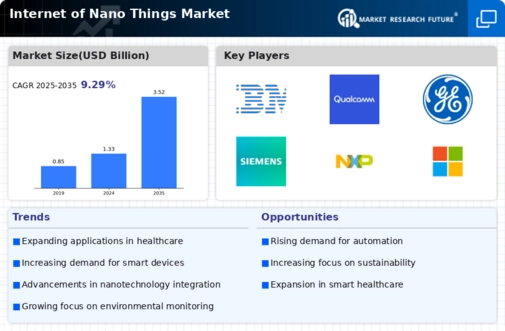Advancements in Nanotechnology
The Internet of Nano Things Market is experiencing a surge due to rapid advancements in nanotechnology. Innovations in materials science and engineering have led to the development of nanosensors and nanodevices that can communicate and process data at unprecedented scales. These advancements enable applications across various sectors, including healthcare, where nanoscale devices can monitor patient health in real-time. The market for nanotechnology is projected to reach approximately 125 billion USD by 2025, indicating a robust growth trajectory. This growth is likely to drive the Internet of Nano Things Market as more industries seek to integrate these advanced technologies into their operations.
Integration with IoT Ecosystems
The Internet of Nano Things Market is increasingly benefiting from the integration of nano devices with existing Internet of Things (IoT) ecosystems. This integration allows for enhanced data collection and analysis, leading to improved decision-making processes across various sectors. For instance, in smart cities, nanosensors can monitor environmental conditions, contributing to better urban planning and resource management. The IoT market is expected to grow to 1.1 trillion USD by 2026, suggesting that the synergy between IoT and nanotechnology could significantly enhance the Internet of Nano Things Market, fostering innovation and efficiency.
Growing Demand for Wearable Technology
The Internet of Nano Things Market is poised for growth due to the increasing demand for wearable technology. As consumers seek more sophisticated health monitoring solutions, nanoscale devices embedded in wearables can provide real-time data on vital signs and physical activity. This trend is particularly evident in the fitness and healthcare sectors, where the market for wearable devices is projected to reach 60 billion USD by 2025. The integration of nanotechnology into wearables not only enhances functionality but also improves user experience, thereby driving the Internet of Nano Things Market forward.
Sustainability and Environmental Impact
The Internet of Nano Things Market is increasingly influenced by the global focus on sustainability and reducing environmental impact. Nanosensors can play a crucial role in monitoring pollution levels and resource usage, enabling industries to adopt more sustainable practices. For example, in agriculture, nanosensors can optimize water usage and reduce chemical runoff, contributing to more sustainable farming practices. The market for environmental monitoring technologies is projected to grow significantly, suggesting that the Internet of Nano Things Market could leverage these trends to promote eco-friendly solutions and enhance its market presence.
Enhanced Data Security and Privacy Solutions
The Internet of Nano Things Market is likely to benefit from the growing emphasis on data security and privacy. As more devices become interconnected, the need for robust security measures becomes paramount. Nanoscale security solutions, such as quantum encryption and advanced authentication methods, are emerging to address these concerns. The Internet of Nano Things is expected to reach 345 billion USD by 2026, indicating a significant opportunity for the Internet of Nano Things Market to incorporate advanced security features into nano devices, thereby enhancing consumer trust and adoption.
























Leave a Comment